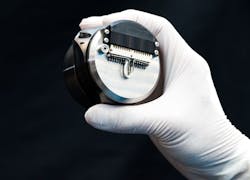Draper to build and upgrade fiber-optic inertial guidance systems for Trident II submarine nuclear missiles
WASHINGTON – U.S. Navy strategic missiles experts needed a company to build and test interferometric fiber optic gyros (IFOGs) for submarine-launched Trident II (D5) nuclear missiles. They found their solution from the The Charles Stark Draper Laboratory Inc. in Cambridge, Mass.
Officials of the Navy Strategic Systems Programs in Washington announced a $73.1 million order to Draper last week to build IFOGs, accelerometers, and Trident II nuclear missile guidance subsystem material.
The IFOG provides inertial navigation and guidance for the Trident II missile. Nuclear missiles must have ultra-reliable self-contained guidance systems that do not rely on outside signals such as satellite navigation systems.
IFOGs have low-mass solid-state configurations that give them advantages like high reliability and lifetimes, the ability to withstand shock and vibration, a large dynamic range, a wide bandwidth, and low power consumption.
Outside munitions applications, IFOGs also are for automotive, aircraft, and satellites, satellite antennas pointing and tracking, mining and tunneling operations, and helicopter attitude control.
Draper Lab is designing the boost guidance system for the Trident II missile to keep the nuclear weapon system operating through at least 2042. The company is replacing inertial measurement units, electronic assemblies, electronic modules and mission-critical flight and shipboard-test software for the Trident submarine fleet.
These systems upgrades are designed to fit into the space within the missile used by the previous system, and Draper engineers modified radiation-hardened technologies to withstand the rigors of the strategic missile application.
Draper is using a modular design approach that allows simultaneous development of several solutions for higher-risk components, such as gyroscopes. Draper engineers have adapted commercial technologies such as fiber-optics for gyroscopes and magnetoresistive memory.
The Trident II D5 is one of the most advanced long-range submarine-launched nuclear missiles in the world. It is the primary U.S. sea-based nuclear ballistic missile, and is deployed aboard U.S. Navy Ohio-class ballistic missile submarines.
The U.S. Navy operates 14 of these ballistic missile submarines, each of which can carry as many as 24 Trident II missiles. Although the Trident II is designed to carry as many as 12 multiple independently targetable reentry vehicle (MIRV) warheads, current treaties reduce this number to four or five.
Each Trident II missile has a range of 4,000 to 7,000 miles, and its guidance subsystem uses a combination of inertial and celestial navigation. The Trident II D5 was first deployed in 1990 and is scheduled to remain in service until at least 2027.
The Navy started the D5 Life Extension Program in 2002 to replace obsolete components using as many commercial off-the-shelf (COTS) parts as possible to keep costs down and to enhance the missile's capability. Draper Lab is in charge of upgrading the Trident II's guidance system.
In practice, the Trident II missile's inertial measurement system receives targeting data from computers aboard the submarine. The inertial measurement unit then transmits signals to the D5 flight-control computer and converts them into steering commands to keep the ballistic missile on target.
On this order Draper will do the work in Cambridge and Pittsfield, Mass.; and Clearwater, Fla., and should be finished by July 2027. For more information contact Draper online at www.draper.com, or the Navy Strategic Systems Programs office at www.ssp.navy.mil.
About the Author
John Keller
Editor-in-Chief
John Keller is the Editor-in-Chief, Military & Aerospace Electronics Magazine--provides extensive coverage and analysis of enabling electronics and optoelectronic technologies in military, space and commercial aviation applications. John has been a member of the Military & Aerospace Electronics staff since 1989 and chief editor since 1995.
